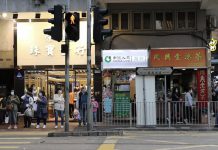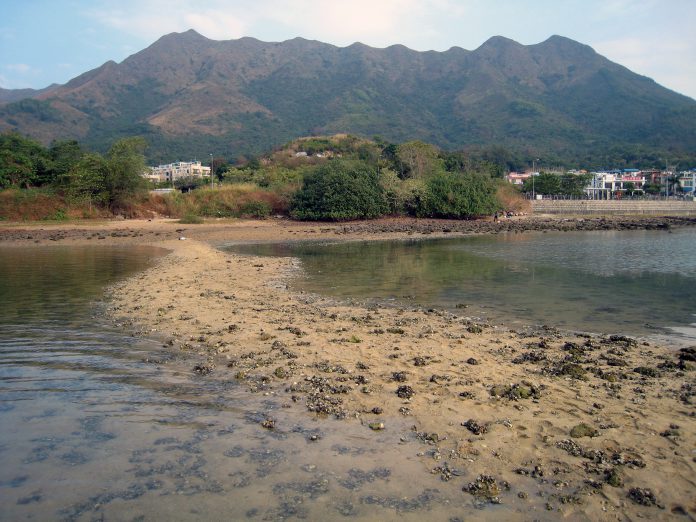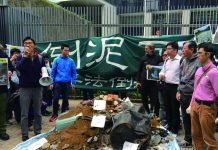System designed to mitigate environmental damage is marred by vested interests and red tape
by Doris Yu & Rammie Chui
The stretch of coastline next to the Ting Kok mangrove in Tolo Harbour and near Lung Mei Village, Tai Po, is one of Annie Ma Ng Sau-yee’s favourite places. She likes to comb the shore for creatures such as starfish, mudskippers and seahorses while her dog swims happily in the water. This ecological treasure trove is just a 10-minute walk away from her apartment in Lung Mei Village.
“The coastline is a discovery centre which brings me to the wonderful ocean world,” says the 51-year-old homemaker. But she did not always think this way.
In 2008, when she first heard about the government’s plan to turn the natural coastline into a 200-metre-long bathing beach with a low-wall at either end, she and most of her neighbours welcomed it. They were told the works would provide swimming facilities for one million residents of the eastern region of the New Territories. Like many residents in the areas, Ma expected the development would increase the value of their property.
However, taking part in activities at the Tai Po Geoheritage Centre – a centre run by the non-profit Environmental Association to educate people on geoparks and ecological diversity – opened Ma’s eyes to the ecological value of the Lung Mei coastline. She later became a volunteer for the Save Lung Mei Alliance, a group advocating for the protection of Lung Mei’s natural beauty.
But it was too late. The project proposed by the Lands Department had received the green light in 2007, after the Environmental Protection Department (EPD) approved its Environmental Impact Assessment (EIA) report and issued an environmental permit for the construction. The 797-page report characterised the muddy tidal coastline as providing “mainly low-quality habitats” for wildlife.
Under the EIA Ordinance, introduced in 1998, EIA is a process government-initiated and private large-scale projects must undergo before they can be approved. Its stated purpose is to avoid and minimise any adverse impact on the environment and propose compensatory measures. However, critics have identified a number of problems with it, including potential conflicts of interest, inadequate public consultation and limitations of the procedure itself.
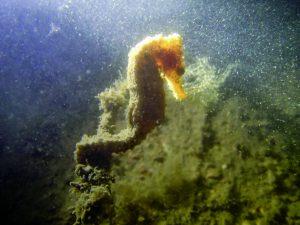
The procedure requires a project’s proponent to hire a consulting firm to prepare the EIA Report. After the report is released, there is a 30-day period during which members of the public can review the report and file written submissions to the EPD. Meanwhile, the Advisory Council on the Environment (ACE), which is appointed by the Chief Executive and comprises scholars, green group representatives and business professionals, will examine and comment on the report within 60 days.
After the EPD director has taken the council’s suggestions into account, he or she will issue the environmental permit if the assessment has been approved. Only then can the project proponent start construction.
The 2007 EIA report for Lung Mei’s man-made beach project, used a quadrat sampling method – where researchers isolate random plots and count the organisms and species found within it – to estimate the distribution of flora and fauna. There were two investigations, one in March representing the dry season, and the other in April representing the wet season. The report said only six intertidal species were found and that the coastline had “low ecological value”.
Experts in ecology and conservationists questioned the report’s credibility. Hong Kong Wildlife Forum, an online platform for nature lovers and environmental experts, carried out its own ecological study of the coastline. Their year-long study recorded the presence of 216 marine species, 36 times the number found in the EIA.
The amateur research also discovered spotted seahorses, a species classified as “vulnerable” by the International Union for Conservation of Nature, and 17 other rare species.
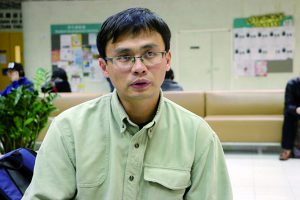
“The 200-metre coastline wows us! It’s so short, so ugly but with rich with wildlife” says Dickson Wong Chi-chun, spokesperson of the Save Lung Mei Alliance and a member of the Hong Kong Wildlife Forum.
The biology teacher says the quadrat sampling method may not be reliable as the researcher can easily control the result by placing the quadrat on a spot which has fewer creatures. Wong adds that taking samples in March and April is not representative enough as the difference in climate conditions is insignificant. In Hong Kong Wildlife’s research, Wong and his peers actively searched for marine species and recorded every species they found by taking photos.
Responding to public pressure, the ACE ordered a supplementary study in 2008. This time, the consulting firm found 67 species using additional extensive intertidal surveys, including active search and quantitative surveys.
The Lung Mei report was also criticised for unfairly comparing the Lung Mei coastline to three other sites in the East New Territories as possible candidates for the construction of the artificial beach. The alternative sites, Tolo Channel, Hoi Ha Wan and Long Harbour, are also high in ecological value, adjoin country parks and have no nearby existing infrastructure.
Save Lung Mei Alliance’s Dickson Wong is disappointed with the system. “The EIA procedure is a rubber stamp. It twists the reality in favour of the development,” he says.
The alliance suggested alternatives to provide more swimming facilities but the authorities dismissed their ideas. When they attempted to directly talk to the EPD and ACE, officials arranged for them to watch the ACE’s discussion of the findings of the supplementary report live via videolink instead.
Having exhausted other means, the alliance filed an application for a judicial review of the project on the grounds that the EIA report was misleading because it omitted the ecological value of a rare species of seahorse. It hoped the court would withdraw the project’s environmental permit.
In 2014, the High Court rejected the argument and the alliance appealed. It lost that case in February this year.
Lung Mei is not the only project to face legal challenges to its EIA report. The expansion of Hong Kong International Airport (HKIA) into a three-runway system faces eight requests for a judicial review, two of them over its EIA report. The report was approved and an environmental permit issued in 2014.
The proposed third runway project involves reclaiming 650 hectares of the sea and is located in Chinese white dolphin hotspots. The Hong Kong Dolphin Conservation Society says the infrastructure will create a physical barrier in the water and disrupt dolphin activities and their movement between hotspots. Also, the pollution from the reclamation work and increased sea traffic after and during the construction will put dolphins in danger.
However, in the report, the consultancy predicts the dolphins will temporarily leave Hong Kong territorial waters during the construction and come back seven years later. It concludes that much of the environmental impact is insignificant or minor.
“We think these are assumptions without evidence and they are irresponsible,” says Viena Mak Hei-man, a member of the society’s committee. She questions why the EPD and ACE still trust the EIA report when there are obvious threats to the dolphins.
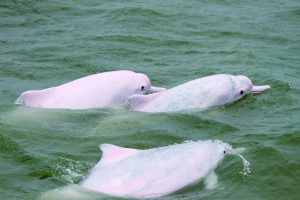
Mak says the new land reclamation will lead to the re-routing of SkyPier high-speed ferry services, a new route connecting the airport to the Mainland and Macau, posing a fatal threat to the dolphins. While the originally proposed third runway is less than 1 km away from the Sha Chau and Lung Kwu Chau Marine Park, the new route will run along the edges of the park. Although the EIA report suggests limiting sailing speed, conservationists say the vessels could still hit and cut the dolphins.
Other potential victims of the third runway are residents of Ma Wan, an island located between Lantau and Tsing Yi. Currently, aircraft leaving Hong Kong fly to the south of Ma Wan after take-off and residents there fear noise pollution will worsen once the third runway operates since there will be 102 flights per hour, compared to the current 68.
Roy Tam Hoi-pong, Tsuen Wan district councillor for the Ma Wan constituency and chief executive of Green Sense did a 20-minute observation of noise exposure last year. Nine aeroplanes passed and he recorded decibel levels above 80 – loud enough to wake a soundly sleeping person – as they flew near the island.
However, the EIA report’s Noise Exposure Forecast predicts noise produced by the increased air traffic will not affect Ma Wan. The forecast was based on two assumptions – that airlines will use quieter aircraft types and that the Civic Aircraft Department will restrict aircraft noise impact.
“It is ‘environmental impact prediction’ instead of ‘environmental impact assessment’,” says Tam. “They [the consulting firm] tried to add other parameters until the model shows that the noise will not affect Ma Wan.”
Tam and the residents participated in the public consultation and campaigned for the environmental permit to be withdrawn, but he thinks it is difficult for ordinary people to absorb information and express their concerns through the EIA procedure.
For starters, the full EIA report is only available in English and is full of jargon. The EPD only offers a Chinese version of the Executive Summaries which is published months before the official report is completed. Also, the public may not have sufficient time to comprehend the 1,227-page-long report and give reasonable advice during the 15-day public inspection period of the project profile and 30 day consultation period on the report.
Secondly, there is a problem with potential conflicts of interest. Tam questions the independence of the consultancies who conduct assessment reports since they are directly hired by the project proponent.
In the case of the Hong Kong Section of Guangzhou-Shenzhen-Hong Kong Express Rail Link, the MTRC, the project proponent, hired AECOM Asia Company Limited as the construction contractor. In turn, AECOM Asia hired AECOM Environment, a consultancy under AECOM to conduct the EIA report. Varsity contacted AECOM Asia Company Limited for comments but they refused to be interviewed.
Without a system of checks and balances, Tam says most EIA reports will claim any damage is “acceptable” and “limited” no matter how destructive the construction works will be.
“[The EIA procedure] is wrapped in layers of injustice,” he says.
In the case of the third runway, the Airport Authority, which is a statutory body of the government, proposed the plan with full government support. The ACE members, who are appointed by the chief executive, passed the EIA report. Then, the EPD director, who is a civil servant, made the final decision to issue the environmental permit.
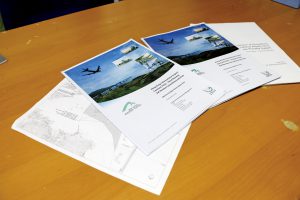
“[The government] is the referee, the player and probably the assistant referee,” Gabrielle Ho Ka-po, a project manager of Green Sense, adds. Since EIAO enforcement in 1998, only one EIA report has been rejected by the EPD director.
In response to questions about the reliability of EIA reports, the EPD described the EIA procedure as a “professional, objective and transparent” procedure in a written reply to Varsity.
However, Chau Kwai-cheong, deputy chairman of the ACE and a retired professor of geography and resource management at the Chinese University of Hong Kong, admits there are loopholes in the system.
“[The project proponent and consultancy] may drink beers together and do each other a favour,” he says. “EIA is not science, it’s ‘half’ science. There is no absolute objectivity,” he adds.
For instance, a consultant may choose a different scienctific model and apply different assumptions in order to get a favourable result in an EIA, yet, this would not violate the terms of the EIAO.
Since the EIA report on the expansion of the airport satisfied every EIAO requirement and incorporated some compensatory measures suggested by the ACE members, Chau says he had no grounds to reject the report even though he questions whether there is a need for the project and is concerned about the survival of Chinese white dolphins.
“I have no choice,” says Chau, “it’s like swallowing a bitter pill, being forced to accept.”
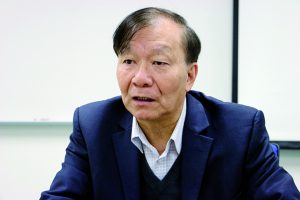
As the government promotes sustainable development, that is finding a balance between the community, the environment and the economy, Chau says the EIA is inadequate. He thinks the government should also design a social impact assessment that is applicable to big-scale projects and which would involve rehousing plans.
“The government, especially the current one, emphasises development,” says Chau, “No one knows what balance is; I don’t really know.”
Edited by Zoe Tam


























